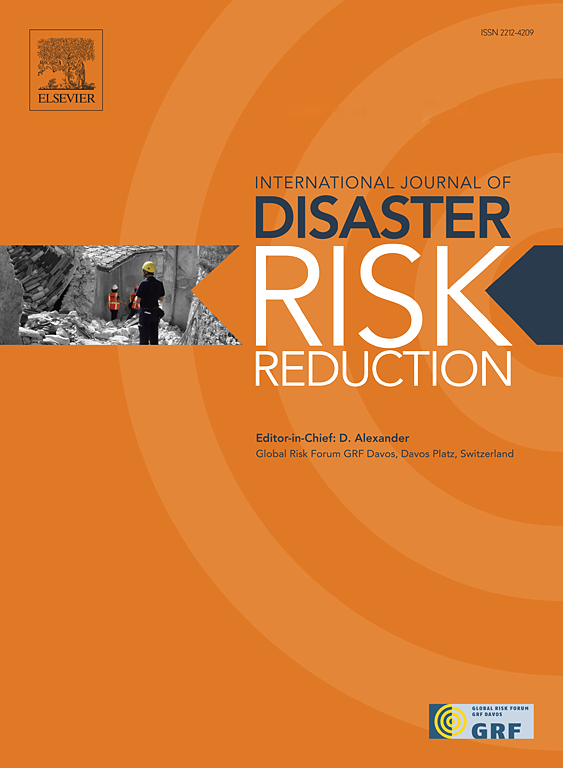用复杂网络方法量化高密度沿海城市的防洪能力:以澳门为例
IF 4.5
1区 地球科学
Q1 GEOSCIENCES, MULTIDISCIPLINARY
International journal of disaster risk reduction
Pub Date : 2025-03-01
DOI:10.1016/j.ijdrr.2025.105335
引用次数: 0
摘要
城市抗洪能力是高密度沿海城市面临的一个关键挑战,在这些城市,传统的基于基础设施的方法往往无法捕捉到物理系统、功能恢复和级联破坏之间的动态相互作用。本文以澳门半岛为例,介绍了一种基于复杂网络理论的弹性评估框架。通过将城市基础设施建模为节点(建筑)和边缘(道路)的互联网络,该框架通过三个核心能力:抵抗、吸收和恢复来量化弹性。该分析将基于场景的洪水模拟与网络指标相结合,以评估系统漏洞并确定恢复力的关键决定因素。结果显示,澳门高密度市区的防洪能力明显不足,特别是在风暴潮和极端降雨相结合的复合洪水事件下。研究结果强调了道路网络冗余和庇护所可达性的关键作用,因为冗余度较低的地区恢复时间较长。模型验证证实了该框架在量化弹性动态方面的有效性,尽管其目前对物理基础设施的关注在捕捉社会经济和制度因素方面存在局限性。尽管如此,本研究为在未来的研究中整合这些维度奠定了可扩展的基础。通过将网络拓扑与功能恢复动态联系起来,本研究推进了对城市抗洪能力的理论认识,同时为决策者优先考虑沿海城市的基础设施投资和抗洪能力规划提供了可操作的见解。本文章由计算机程序翻译,如有差异,请以英文原文为准。
A complex network approach to quantifying flood resilience in high-density coastal urban areas: A case study of Macau
Urban flood resilience is a critical challenge for high-density coastal cities, where traditional infrastructure-based approaches often fail to capture the dynamic interactions between physical systems, functional recovery, and cascading disruptions. This study introduces a novel resilience assessment framework based on complex network theory, applied to the Macau Peninsula as a case study. By modeling urban infrastructure as an interconnected network of nodes (buildings) and edges (roads), the framework quantifies resilience through three core capacities: resistance, absorption, and recovery. The analysis integrates scenario-based flood simulations with network metrics to assess system vulnerabilities and identify key determinants of resilience. Results reveal significant weaknesses in Macau's high-density urban areas, particularly under compound flood events combining storm surges and extreme rainfall. Findings underscore the critical role of road network redundancy and shelter accessibility, as areas with lower redundancy experience prolonged recovery times. Model validation confirms the framework's effectiveness in quantifying resilience dynamics, though its current focus on physical infrastructure presents limitations in capturing socioeconomic and institutional factors. Nonetheless, this study establishes a scalable foundation for integrating such dimensions in future research. By bridging network topology with functional recovery dynamics, this work advances the theoretical understanding of urban flood resilience while offering actionable insights for policymakers to prioritize infrastructure investments and resilience planning in coastal cities.
求助全文
通过发布文献求助,成功后即可免费获取论文全文。
去求助
来源期刊

International journal of disaster risk reduction
GEOSCIENCES, MULTIDISCIPLINARYMETEOROLOGY-METEOROLOGY & ATMOSPHERIC SCIENCES
CiteScore
8.70
自引率
18.00%
发文量
688
审稿时长
79 days
期刊介绍:
The International Journal of Disaster Risk Reduction (IJDRR) is the journal for researchers, policymakers and practitioners across diverse disciplines: earth sciences and their implications; environmental sciences; engineering; urban studies; geography; and the social sciences. IJDRR publishes fundamental and applied research, critical reviews, policy papers and case studies with a particular focus on multi-disciplinary research that aims to reduce the impact of natural, technological, social and intentional disasters. IJDRR stimulates exchange of ideas and knowledge transfer on disaster research, mitigation, adaptation, prevention and risk reduction at all geographical scales: local, national and international.
Key topics:-
-multifaceted disaster and cascading disasters
-the development of disaster risk reduction strategies and techniques
-discussion and development of effective warning and educational systems for risk management at all levels
-disasters associated with climate change
-vulnerability analysis and vulnerability trends
-emerging risks
-resilience against disasters.
The journal particularly encourages papers that approach risk from a multi-disciplinary perspective.
 求助内容:
求助内容: 应助结果提醒方式:
应助结果提醒方式:


